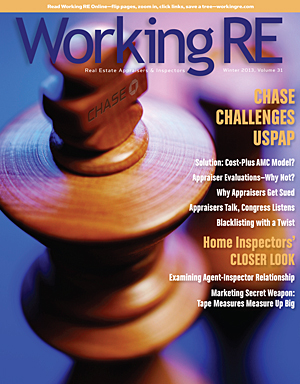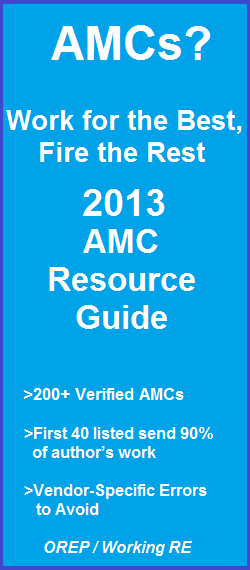
|
Published by OREP, E&O Insurance Experts | Jan. 2, 2013 | Vol. 268 |
 Click to Read Current Issue |
>
Am I a Working RE Paid Subscriber?
> Blogs > Comment on Story Below
|
"With
the banks needing to raise the bar for Evaluations, appraisers are well-suited
to produce reports that meet the new expanded requirements."
New Survey: How Reasonable are Appraisal Turn Times?
Editor’s Note:
Happy News for the New Year:
you can increase
business with
Evaluations.
Evaluations – Tapping “New” Source of Business
by Joshua Walitt
There’s been a good deal of interest lately about
Evaluations: who is writing them, and
more importantly, who is not writing them and missing out on potential valuation
business. Evaluations are those
valuation reports that banks can use, under the
Interagency Guidelines and in certain
lending situations, which don’t require but do allow the engagement of
appraisers. Here’s how to tap this “new” source of business.
Strictly speaking, the minimum requirements for completing an Evaluation do not
meet federal requirements for completing an appraisal, as laid out in the
Uniform Standards of Professional Appraisal Practice (USPAP).
If appraisers are required to meet
USPAP, can they prepare Evaluations? If
appraisers can prepare USPAP-compliant evaluations, what are the reporting
requirements, and given what is required, does it even make sense to add
Evaluations to your list of services? Answers to follow!
Evaluations: Yes You Can
There should be no confusion: appraisers
CAN write Evaluations today. USPAP does not prevent appraisers from preparing
Evaluations, no matter what you’ve read or heard.
The issue is that most appraisers (except in
North Carolina, Virginia, and Tennessee) are held to USPAP
requirements when producing Evaluations. In other words, an appraiser producing
an Evaluation report must meet two different sets of requirements; the report
must not only meet the Federal requirements for an Evaluation, but also the
requirements of USPAP. Consequently,
each appraiser has to weigh whether doing Evaluations is worth the time and
effort.
Interestingly, the gap between the reporting requirements of an Appraisal and
an Evaluation has decreased due to the 2010 revision of the
Interagency Guidelines. The
revision brought expanded requirements
for the content of an Evaluation. Evaluations, often regarded as the
“lower-quality” cousin of an appraisal, now must contain descriptions of the
inspection, analyses and supporting information used in valuing the property.
Compare it to a Restricted-Use Appraisal, where the appraiser can briefly
state the appraisal methods, techniques and conclusions – providing fewer
details in the report itself.
How many banks in your
community order Broker Price Opinions (BPOs) or have minimally-trained
individuals completing Evaluations?
With the banks needing to raise the bar for
Evaluations, appraisers are well-suited to produce reports that meet the new
expanded requirements. Why? It is logical to assume that the quality of work
will be higher when prepared by appraisers (as compared to real estate agents or
bank employees), in general, because appraisers are non-biased, trained
valuation experts with no interest in the transaction.
Opponents might claim this legislative approach
lowers the bar for the lending industry’s collateral valuation protocols, at a
time when we should be raising it.
As noted, however, the 2010 Interagency
Guidelines require more of an
Evaluation than they did in the past, including more written support and detail
than even some portions of a USPAP Restricted-Use Appraisal. So the question is
not whether appraisers can do Evaluations, but whether they make sense from a
business perspective.
Appraisals vs. Evaluations
To know whether Evaluations make sense for your
practice, you must first understand what you’re required to do. The core
components that we would generally expect to find in any reliable valuation
report are required for both an Evaluation and a Restricted Use Appraisal. For
example, we find the mutual elements of the identification of the property, the
estimate of value, the value date, and the inclusion of information regarding
analyses, support and other data in both types of reports. But these overlapping
components only go so far.
-
An Evaluation’s requirements lack several items including an estimate of exposure time, citation of the source of the market value definition, Statement of Use and User Restrictions, identification of the report type, and inclusion of specific signed certifications – all of which must be included for the report to be called an Appraisal.
-
Conversely, a Restricted-Use Appraisal allows brief statements regarding certain information, analyses, and property characteristics, whereas an Evaluation requires a more-thorough account of those items.
Think of it like this:
an Evaluation is a cup of coffee with sugar
required; a Restricted-Use Appraisal is a coffee with cream required. The key is
to make your cup of coffee with cream and sugar included – so both sets of
requirements are satisfied.
Giving the
Client What They Want
The banks, per the Interagency Guidelines, need
at least an Evaluation.
The appraiser, per USPAP, must prepare at
least an Appraisal. The focus isn’t on what label you put at the top of the page
– in the end, the content will reveal the type of report. (But, yes, USPAP does
require a formal identification of the report type.)
So, the
question shouldn’t be can you provide Evaluations to banks because you surely
can. Instead, we should ask ourselves, “Do I understand the requirements for
developing and writing these reports?”; “For what properties will I write
Evaluations?” and “What Scope of Work choices do I have?”
Pricing
Know that I am a full-fee appraiser. I charge
fees that fairly compensate me for the time and effort necessary to produce a
quality report –I don’t accept the mini-fees that some companies offer. So I
don’t expect to get all the Evaluation business in my area, nor do I expect that
I will accept every Evaluation assignment offered. I have produced Evaluations
and know it is unlikely they will make up the bulk of my work. (I perform rent
studies too, and they also do not make up the bulk of my business but they do
round out the range of products I offer.)
The fact that some banks are already engaging appraisers
for this type of assignment dismisses the argument suggesting appraisers will
never be asked to provide Evaluations. But an appraiser is guaranteed to receive
no Evaluation assignments if they don’t offer the product or never ask for the
business.
Doing it By the Book (USPAP)
As you prepare to produce Evaluations, don’t look to
any article – including this one – for an exhaustive list of requirements. Go to
the sources yourself:
read the 2010 Interagency Guidelines and USPAP
Standards 1 and 2. Don’t rely on a class, an existing pre-printed form, or the
work samples of others to instruct you. Instead, produce your own thorough list
of the necessary elements and then make sure your process and form are
sufficient. The Appraisal Institute’s Guide Note 13 is a good outline, but don’t
simply cut-and-paste it – confidently understand if the process that you design
is adequate or not.
A good reminder, applicable
to so many appraisal issues, often comes up at our office’s monthly meetings:
“We’re all independent appraisers– so we all
need to make our own decisions.”
Accept/Decline Parameters
Do you accept every assignment that is offered to
you?
Probably not, and it will be no different with
Evaluation assignments.
With the somewhat more-abridged nature of the
Evaluation (compared to a Summary Appraisal used in the industry), you might
find an Evaluation is not appropriate (or cost effective) for complex
assignments.
For example, will you accept Evaluation assignments for
properties having log construction, four acres, one bedroom, fully-below-grade,
an atypical design, or in a market area that has limited recent sales? In many
markets, these characteristics can indicate a complex property, where the
necessary scope of work to produce a reliable report will need fuller – and
probably more time-consuming – development and reporting.
Also, be aware that you’re not the only party needing to
make important decisions. Within the Guidelines, banks are specifically
instructed that:
-
BPOs and AVMs in and of themselves are not acceptable as Evaluations,
-
selection of the valuation method (Evaluation or Appraisal) should not be based on the lowest fee,
-
and atypical, or complex, properties may require an upgrade from an Evaluation to an Appraisal.
So, how will you determine
and communicate your own “accept/decline parameters” to your client, regarding
assignments they offer you?
What product upgrade will you offer your
client in cases of complex properties which are not suited for the Evaluation
product? The Interagency Guidelines instruct the bank that upgrades from
Evaluations to Appraisals will likely need to meet Summary Appraisal report
requirements. Not only does this decision making process protect the bank, it
also provides a fail-safe for your time and your fee.
Fees are influenced by a variety of factors, and invariably some fees will be inadequate for the amount of work required for a particular product. On a regular basis already, many appraisers are countering or declining mini-fee assignments, and Evaluations will be no different. Appraisers are good at valuing properties, but are they all good at valuing their own work.
Scope Choices
We’ve all heard
someone claim that USPAP is too restrictive, but in general, the Standards are
actually quite broad in their allowances. So, when you approach new and existing
clients regarding the Evaluation product you offer, you’re going to have scope
questions to answer, including the following:
What type of subject inspection will you make?
-
a desk inspection using a prior appraisal or MLS, within a certain timeframe,
-
a from-street personal inspection,
-
an inspection performed by someone else,
-
or another type of inspection?
What will the reporting of the value
be?
-
a single-point dollar figure,
-
a range,
-
or a relative figure?
Will the sales grid have adjustments
that are-
-
quantitative,
-
or qualitative?
What type of inspection will you
complete for the comps?
-
personal from the street,
-
or the MLS and public data only?
As always, in the end, the final scope of work choices are yours, to ensure you are producing a reliable report for the bank’s use.
Making Things Happen
An article in the current edition of
Working RE magazine suggests a
permanent solution to the Appraisal vs. Evaluation question is to enact
legislation which authorizes appraisers to write Evaluations by exempting them
from meeting USPAP requirements on these reports (Appraiser
Evaluations-Why Not?, pg. 16). While it’s true this solution would end the
debate, appraisers in the 47 states without such legislation don’t have to wait
to go after this business. USPAP does not prohibit appraisers from producing
Evaluations but appraisers do have to decide if it is worth their time and
effort. Choose to offer Evaluations to your clients today and run the numbers to
see if it is the right fit for your business.
About the Author
Joshua Walitt is a Certified
Residential Appraiser in Colorado, VA- and FHA- approved, and speaker to lending
and real estate groups. He has been a Hearing Officer for the Mesa County Board
of Equalization, and will serve on Colorado’s ‘AMC Rules Task Force’ for 2013.
Reach him on LinkedIn or @joshwalitt on twitter.
Editor’s Question:
What are your experiences doing Evaluations?
HTML Comment Box is loading comments...
ATTENTION: You are receiving WRE Online News because you opted in at WorkingRE.com or purchased E&O insurance from OREP. WRE Online News Edition provides news-oriented content twice a month. The content for WRE Special Offer Editions is provided by paid sponsors. If you no longer wish to receive these emails from Working RE, please use the link found at the bottom of this newsletter to be removed from our mailing list.



